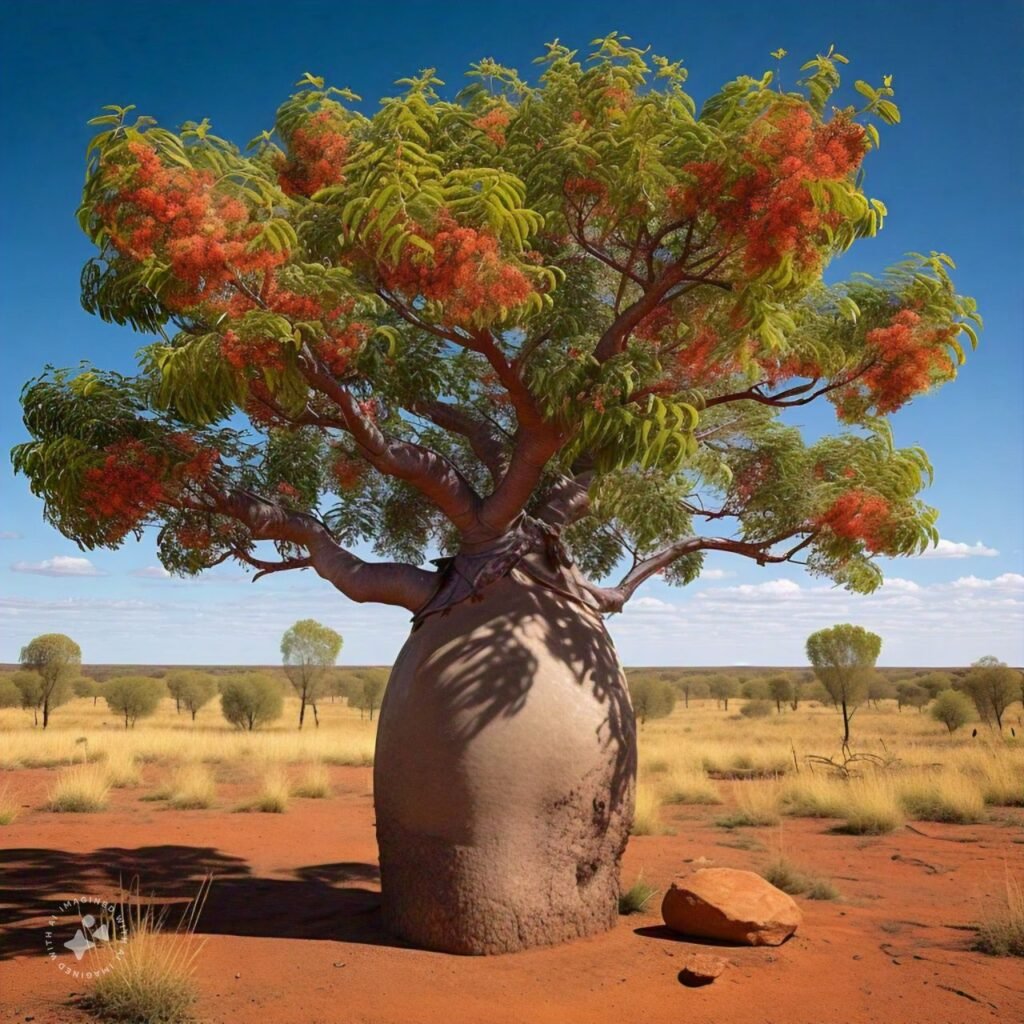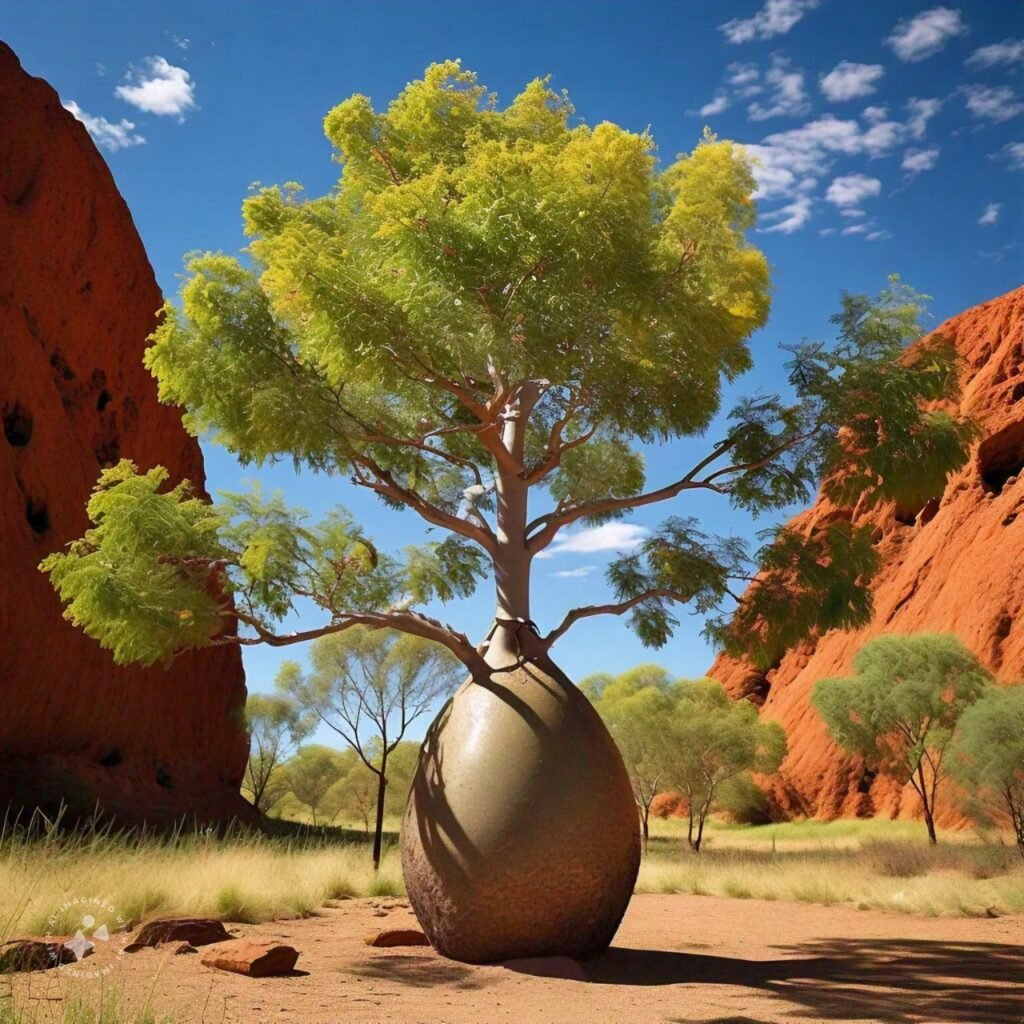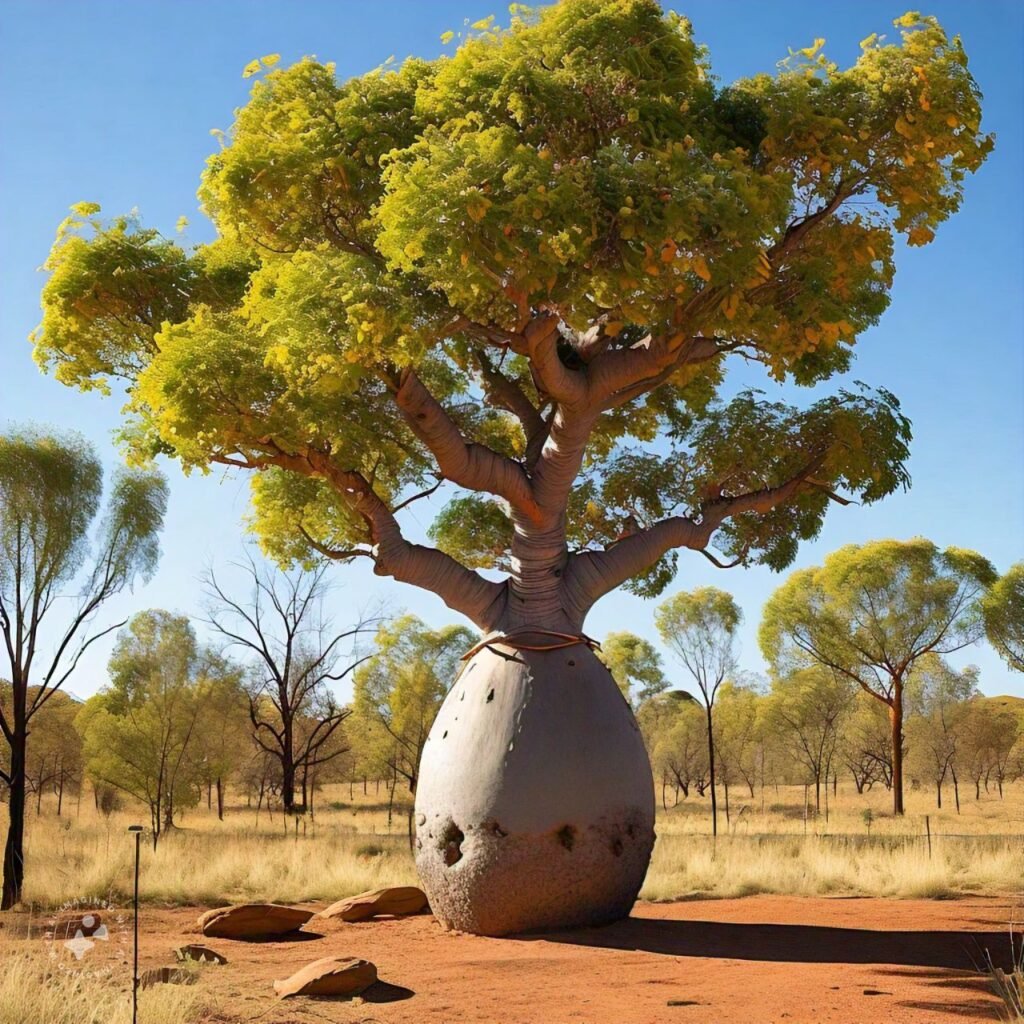Australia

The most famous bottle tree in Australia is the Queensland Bottle Tree (Brachychiton rupestris).
Indigenous Australians have long used bottle trees for food, water storage, and medicinal purposes. The swollen trunks, which store water, made them invaluable in the arid Australian interior. European settlers also found them useful, particularly during droughts.
The tree holds cultural significance for many Aboriginal communities and is often featured in Indigenous artwork.
Madagascar
The Adansonia grandidieri, a type of baobab tree, is often referred to as a bottle tree in Madagascar.
These trees are endemic to Madagascar and have adapted to the island’s dry climate. They are ancient trees, with some estimated to be over a thousand years old.
The trees are revered in Malagasy culture and are often associated with myths and legends. They are also crucial for local ecosystems, supporting various species and providing resources for human use.

Namibia

The Pachypodium lealii, commonly known as the bottle tree, is native to Namibia.
This species thrives in the arid regions of Namibia, where it has evolved to store water in its thick trunk. The tree has long been a part of the local landscape, providing resources for both humans and animals.
The Himba people of Namibia use the tree for various purposes, including as a source of water during dry periods.
South Africa
The Pachypodium lealii also grows in parts of South Africa, along with other bottle-like trees such as Moringa ovalifolia.
These trees are adapted to the semi-arid regions of South Africa and have been used historically by indigenous peoples for water storage and other resources.
The trees are part of the natural heritage of the region and are often used in traditional medicine and other cultural practices.

United States

The bottle tree tradition in the U.S. is more of a cultural practice than a reference to a specific plant. However, the practice involves using bottles placed on tree branches to ward off evil spirits.
The tradition is believed to have originated in the Congo and was brought to the U.S. by enslaved Africans. It became particularly popular in the Southern United States.
Today, bottle trees are seen as a symbol of Southern folklore and African American heritage, with the practice continuing in various parts of the U.S.
Mexico
This giant cactus can store significant amounts of water in its trunk, allowing it to survive in Mexico’s arid regions. It has been used by indigenous peoples for centuries.
The Pachycereus pringlei cactus, sometimes referred to as a “tree-like” bottle plant, is native to Mexico.
The cactus is an important part of the desert ecosystem and is used in various traditional practices, including food and medicine.

Socotra (Yemen)

The Adenium obesum, often referred to as the “desert rose,” resembles a bottle tree and is native to Socotra.
This tree has adapted to the harsh, arid environment of the island, where it stores water in its swollen trunk. It has been part of the island’s landscape for millennia.
The tree is valued for its beauty and its resilience, symbolizing survival in harsh conditions. It is also used in traditional medicine.
Botswana
The Moringa ovalifolia is native to Botswana and resembles a bottle tree.
Like other bottle trees, this species stores water in its trunk and is well-adapted to the dry climate of Botswana. It has been used by local communities for food, medicine, and water storage.
The tree is an important resource in the region, providing food and medicinal products

Australia

The most famous bottle tree in Australia is the Queensland Bottle Tree (Brachychiton rupestris).
Indigenous Australians have long used bottle trees for food, water storage, and medicinal purposes. The swollen trunks, which store water, made them invaluable in the arid Australian interior. European settlers also found them useful, particularly during droughts.
The tree holds cultural significance for many Aboriginal communities and is often featured in Indigenous artwork.
Madagascar
The Adansonia grandidieri, a type of baobab tree, is often referred to as a bottle tree in Madagascar.
These trees are endemic to Madagascar and have adapted to the island’s dry climate. They are ancient trees, with some estimated to be over a thousand years old.
The trees are revered in Malagasy culture and are often associated with myths and legends. They are also crucial for local ecosystems, supporting various species and providing resources for human use.
Namibia
The Pachypodium lealii, commonly known as the bottle tree, is native to Namibia.
This species thrives in the arid regions of Namibia, where it has evolved to store water in its thick trunk. The tree has long been a part of the local landscape, providing resources for both humans and animals.
The Himba people of Namibia use the tree for various purposes, including as a source of water during dry periods.
South Africa
The Pachypodium lealii also grows in parts of South Africa, along with other bottle-like trees such as Moringa ovalifolia.
These trees are adapted to the semi-arid regions of South Africa and have been used historically by indigenous peoples for water storage and other resources.
The trees are part of the natural heritage of the region and are often used in traditional medicine and other cultural practices.
United States
The bottle tree tradition in the U.S. is more of a cultural practice than a reference to a specific plant. However, the practice involves using bottles placed on tree branches to ward off evil spirits.
The tradition is believed to have originated in the Congo and was brought to the U.S. by enslaved Africans. It became particularly popular in the Southern United States.
Today, bottle trees are seen as a symbol of Southern folklore and African American heritage, with the practice continuing in various parts of the U.S.
Mexico
The Pachycereus pringlei cactus, sometimes referred to as a “tree-like” bottle plant, is native to Mexico.
This giant cactus can store significant amounts of water in its trunk, allowing it to survive in Mexico’s arid regions. It has been used by indigenous peoples for centuries.
The cactus is an important part of the desert ecosystem and is used in various traditional practices, including food and medicine.
Socotra (Yemen)
The Adenium obesum, often referred to as the “desert rose,” resembles a bottle tree and is native to Socotra.
This tree has adapted to the harsh, arid environment of the island, where it stores water in its swollen trunk. It has been part of the island’s landscape for millennia.
The tree is valued for its beauty and its resilience, symbolizing survival in harsh conditions. It is also used in traditional medicine.
Botswana
The Moringa ovalifolia is native to Botswana and resembles a bottle tree.
Like other bottle trees, this species stores water in its trunk and is well-adapted to the dry climate of Botswana. It has been used by local communities for food, medicine, and water storage.
The tree is an important resource in the region, providing food and medicinal products
Scientific Name: The Bottle Tree is scientifically known as Brachychiton rupestris and is native to Queensland, Australia. It is named for its distinct, swollen trunk, which resembles a bottle, used to store water during dry periods.
Water Storage: The Bottle Tree’s trunk can swell to store vast amounts of water, which helps the plant survive in arid conditions. This adaptation allows it to thrive in areas with inconsistent rainfall.
Longevity: Bottle Trees can live for over 150 years, making them a symbol of endurance and resilience in their native habitat. Some trees are known to be much older, surviving harsh conditions for centuries.
Aboriginal Uses: Indigenous Australians have long used the Bottle Tree as a resource. They extract water from the trunk during droughts and consume the seeds, roots, and even the fibrous bark in times of food scarcity.
Deciduous Nature: Bottle Trees are deciduous, shedding their leaves during the dry season to conserve water. This adaptation is crucial for their survival in the harsh climates of Australia’s outback.
Flowers: The Bottle Tree produces small, bell-shaped flowers that are creamy yellow or greenish-white in color. These flowers bloom in clusters during the summer months, attracting pollinators such as bees and birds.
Slow Growth: Bottle Trees are slow-growing, taking several decades to reach their full height of about 20 meters (65 feet). Their slow growth rate is a reflection of the harsh environments in which they typically grow.
Seed Pods: After flowering, the Bottle Tree produces large, woody seed pods that contain numerous seeds. These pods are often used in traditional crafts and as a food source by indigenous peoples.
Fire Resistance: Bottle Trees have a natural resistance to fire, a crucial adaptation in their native Australian environment, where wildfires are common. Their thick, water-filled trunks help protect them from the heat.
Pest Resistant: The Bottle Tree is highly resistant to pests and diseases, making it a low-maintenance plant for gardens and landscapes. This resilience adds to its popularity as an ornamental tree in various regions.
Ornamental Value: The unique appearance of the Bottle Tree, with its swollen trunk and spreading branches, makes it a popular choice for ornamental planting in gardens and public spaces around the world.
Drought Tolerance: Due to its ability to store water, the Bottle Tree is highly drought-tolerant. This makes it an excellent choice for xeriscaping and other water-conserving landscaping practices in arid regions.
Cultural Symbol: In Australia, the Bottle Tree is often seen as a symbol of endurance and survival, reflecting its ability to thrive in some of the harshest environments on Earth.
Adaptable to Soils: Bottle Trees are adaptable to a wide range of soil types, including sandy, loamy, and even slightly saline soils. This versatility allows them to grow in diverse environments.
Landscape Use: The Bottle Tree is often used in urban landscaping for its aesthetic appeal and hardiness. It is especially valued in drought-prone areas where other trees might struggle to survive.
Bird Habitat: The Bottle Tree provides an important habitat for various bird species. Its flowers, seeds, and the insects they attract offer food for birds, while its branches provide nesting sites.
Pruning: Pruning is not necessary for Bottle Trees, but it can help maintain their shape and encourage a more uniform growth pattern. However, pruning should be done carefully to avoid damaging the trunk.
Propagation: Bottle Trees are typically propagated from seeds, which germinate readily under the right conditions. The seedlings require plenty of sunlight and should be watered sparingly to prevent rot.
Medicinal Uses: In traditional Aboriginal medicine, parts of the Bottle Tree were used to treat various ailments, including respiratory issues and skin infections. The plant’s sap and bark were particularly valued for their medicinal properties.
Climate Preference: Bottle Trees prefer warm, sunny climates and can tolerate a wide range of temperatures, though they are not frost-resistant. They thrive in USDA hardiness zones 9-11.
Root System: The root system of a Bottle Tree is deep and extensive, allowing it to access underground water sources during dry spells. This also helps stabilize the tree in windy conditions.
Frost Sensitivity: Although drought-tolerant, Bottle Trees are sensitive to frost. Prolonged exposure to freezing temperatures can damage the tree, making it less suitable for colder climates.
Indoor Growth: While typically grown outdoors, Bottle Trees can also be cultivated as indoor plants in large pots, provided they receive sufficient light and are not overwatered.
Cultural Representation: In Australian Aboriginal Dreamtime stories, the Bottle Tree is sometimes depicted as a spiritual entity, embodying the strength and resilience required to endure life’s challenges.
Pioneer Species: In some regions, Bottle Trees are considered pioneer species, meaning they are among the first to colonize disturbed or degraded land, helping to stabilize soil and create conditions for other plants to grow.
Bonsai: The Bottle Tree can be grown as a bonsai, though this requires careful pruning and maintenance. Its distinctive trunk and branches make it a striking choice for bonsai enthusiasts.
Timber Use: Although not commonly used for timber, the wood of the Bottle Tree is soft and light. It has been used traditionally to make items like shields, containers, and even musical instruments by indigenous Australians.
Shade Provider: The broad canopy of the Bottle Tree provides ample shade, making it a favored tree for planting in parks and gardens where shade is needed.
Environmental Indicator: The health of Bottle Trees can be an indicator of environmental changes, such as shifts in groundwater levels or soil conditions. Their decline might signal broader ecological issues in their habitat.
Ecotourism Attraction: In Australia, Bottle Trees are often featured in ecotourism, drawing visitors interested in their unique appearance and ecological importance. They are a popular attraction in regions where they are native.
To plant a Bottle Tree in your garden, choose a sunny location with well-draining soil. Dig a hole twice the size of the root ball, place the tree, and backfill with soil. Water thoroughly to help the tree establish.
Bottle Trees thrive in sandy, loamy, or well-drained soils. Ensure the soil is not too compact to avoid waterlogging, which can lead to root rot. Adding compost or organic matter can improve soil structure and fertility.
Water your Bottle Tree deeply once a week during the growing season. In the first year, keep the soil consistently moist but not waterlogged. Once established, Bottle Trees are drought-tolerant and require less frequent watering.
Bottle Trees prefer warm, arid, or semi-arid climates with plenty of sunlight. They are hardy in USDA zones 9-11. In cooler climates, they should be grown in containers and moved indoors during winter to avoid frost damage.
Prune Bottle Trees in late winter or early spring before new growth begins. Remove dead or damaged branches and thin out crowded areas to promote air circulation. Light pruning helps maintain its attractive bottle-like shape.
Common pests include aphids, scale insects, and spider mites. Regularly inspect the plant and treat infestations with insecticidal soap or neem oil. Encouraging beneficial insects like ladybugs can also help control pests naturally.
Fertilize Bottle Trees in early spring with a slow-release, balanced fertilizer (10-10-10). Avoid over-fertilizing, as this can lead to excessive foliage growth at the expense of root and trunk development. Mature trees may not need fertilization every year.
Bottle Trees can be grown in large containers, especially in regions with colder winters. Use a well-draining potting mix and ensure the container has drainage holes. Move the tree indoors during cold weather to protect it from frost.
Bottle Trees have a moderate growth rate, typically growing 12-24 inches per year. Growth can be slower in poor soil or if the tree is not receiving enough sunlight. Proper care, including adequate watering and fertilization, can enhance growth.
To protect your Bottle Tree from frost, wrap the trunk with frost cloth or burlap and cover the base with mulch to insulate the roots. For potted trees, move them indoors or to a sheltered location during freezing temperatures.
What is a Bottle Tree plant?
The Bottle Tree (Brachychiton rupestris) is a unique, drought-resistant tree native to Australia, known for its bulbous, bottle-shaped trunk. The trunk stores water, making it well-suited for arid climates. It can grow up to 18 meters tall and has attractive, lobed leaves.
Where does the Bottle Tree originate?
The Bottle Tree is native to Queensland, Australia. It thrives in dry, arid regions and is a common sight in the outback. Its distinctive shape and drought-resistant nature have made it popular in landscaping in other parts of the world.
Why is it called a Bottle Tree?
The Bottle Tree is named for its swollen, bottle-like trunk, which stores water to help the tree survive in dry conditions. This unique shape is not only functional but also gives the tree its distinctive and striking appearance.
How fast does a Bottle Tree grow?
Bottle Trees grow relatively slowly, especially in their early years. Under ideal conditions, they may grow about 1-2 feet per year. As they mature, their growth rate slows down even further.
What are the uses of a Bottle Tree?
Bottle Trees are primarily used for ornamental purposes due to their unique appearance. Additionally, Indigenous Australians have historically used parts of the tree for food, water storage, and crafting materials.
Can a Bottle Tree survive in cold climates?
Bottle Trees are adapted to warm, dry climates and can tolerate mild frosts. However, they are not suited for very cold or wet climates and may suffer damage or fail to thrive in such conditions.
How much water does a Bottle Tree need?
Bottle Trees are drought-tolerant and require minimal watering once established. During their early years, they need regular watering to establish deep roots, but mature trees can survive on rainfall alone in most climates.
Is the Bottle Tree poisonous?
Bottle Trees are generally not considered poisonous to humans or animals. However, it’s always best to prevent pets and children from chewing on any plant material, as some parts may cause mild digestive upset if ingested.
How do you propagate a Bottle Tree?
Bottle Trees are typically propagated from seeds, which should be soaked in water for 24 hours before planting. They can also be grown from cuttings, though this method is less common and more challenging.
How long does a Bottle Tree live?
Bottle Trees can live for several decades, with some specimens surviving for over 150 years. Their lifespan depends on environmental conditions, care, and whether they are grown in their native habitat or elsewhere.
What soil is best for Bottle Trees?
Bottle Trees prefer well-draining, sandy or loamy soils with a neutral to slightly acidic pH. They can tolerate poor soils but thrive best in fertile, well-aerated ground. Good drainage is crucial to prevent root rot.
Can a Bottle Tree be grown in a pot?
Yes, Bottle Trees can be grown in pots, especially when young. However, they require large containers as they grow, and their extensive root system can make long-term container growth challenging. They should be transplanted to the ground when feasible.
What pests affect Bottle Trees?
Bottle Trees are relatively pest-resistant but can be affected by scale insects, aphids, and borers. Regular monitoring and proper care, such as maintaining healthy soil and avoiding overwatering, can help prevent pest infestations.
Do Bottle Trees lose their leaves?
Yes, Bottle Trees are deciduous and typically lose their leaves in response to dry seasons or during winter. This leaf drop helps reduce water loss, making the tree even more drought-resistant.
What are the flowers of a Bottle Tree like?
Bottle Trees produce small, bell-shaped flowers that can be white, cream, or pink. These flowers typically appear in late spring to early summer and are followed by seed pods containing large seeds.
How big does a Bottle Tree get?
In its natural habitat, a Bottle Tree can grow up to 18 meters (about 60 feet) tall, with a trunk diameter of up to 2 meters (6.5 feet). However, in cultivation, they often remain smaller.
Is a Bottle Tree evergreen?
No, Bottle Trees are not evergreen. They are deciduous, shedding their leaves in response to seasonal changes or dry conditions. This adaptation helps them conserve water during droughts.
How do you care for a Bottle Tree?
Bottle Trees require minimal care once established. They need well-drained soil, full sun, and occasional deep watering during prolonged dry spells. Pruning is rarely necessary, but young trees may need support to develop a straight trunk.
Can Bottle Trees be grown indoors?
While Bottle Trees are typically grown outdoors, young trees can be kept indoors in large containers. They require bright, indirect light and should be gradually acclimated to outdoor conditions if eventually transplanted outside.
What is the scientific name of the Bottle Tree?
The scientific name of the Bottle Tree is Brachychiton rupestris. It belongs to the Malvaceae family and is closely related to other Brachychiton species.
How do Bottle Trees store water?
Bottle Trees store water in their thick, swollen trunks. This adaptation allows them to survive long periods of drought by drawing on the water reserves stored in their trunk tissues.
Are Bottle Trees fire-resistant?
Bottle Trees have some resistance to fire due to their thick bark and water-storing trunk. However, intense or prolonged fires can still damage or kill the tree, especially if the foliage is burned.
Can you eat the seeds of a Bottle Tree?
Yes, the seeds of the Bottle Tree are edible and were traditionally eaten by Indigenous Australians. The seeds are usually roasted to remove toxins before consumption. They can be ground into flour or eaten whole.
How do you prune a Bottle Tree?
Pruning is generally unnecessary for Bottle Trees, but if needed, it should be done in late winter or early spring. Remove any dead or diseased branches, and trim to shape the tree while it’s young.
What are the benefits of planting a Bottle Tree?
Bottle Trees are drought-resistant, require minimal maintenance, and add unique aesthetic value to landscapes. They provide shade, can serve as windbreaks, and attract birds and other wildlife with their flowers and seeds.
Can Bottle Trees tolerate full sun?
Yes, Bottle Trees thrive in full sun and require plenty of sunlight to grow properly. They are well-adapted to hot, arid environments and should be planted in a sunny location for optimal growth.
What climate is best for Bottle Trees?
Bottle Trees are best suited to warm, dry climates. They can tolerate extreme heat and drought but do poorly in cold, wet environments. They are ideally grown in USDA zones 9-11 or equivalent climates.
How do Bottle Trees adapt to drought?
Bottle Trees adapt to drought by storing water in their swollen trunks and dropping their leaves to reduce water loss. Their deep root systems also help them access underground water sources during dry periods.
Can Bottle Trees grow in clay soil?
While Bottle Trees prefer well-drained, sandy or loamy soils, they can tolerate clay soil if it is well-drained. Poorly drained clay can lead to root rot, so it’s important to amend the soil or plant the tree in a raised bed.
What is the cultural significance of Bottle Trees?
Bottle Trees hold cultural significance for Indigenous Australians, who have used them for food, water storage, and crafting materials. The tree is also valued in Australian folklore and is sometimes planted as a symbol of resilience and survival.
